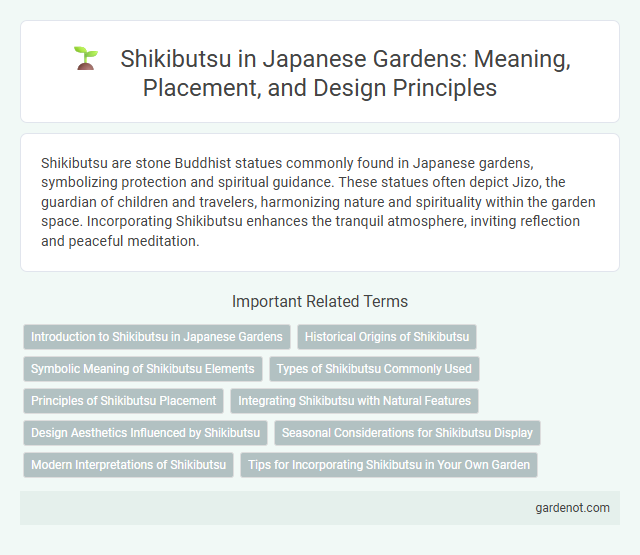Shikibutsu are stone Buddhist statues commonly found in Japanese gardens, symbolizing protection and spiritual guidance. These statues often depict Jizo, the guardian of children and travelers, harmonizing nature and spirituality within the garden space. Incorporating Shikibutsu enhances the tranquil atmosphere, inviting reflection and peaceful meditation.
Introduction to Shikibutsu in Japanese Gardens
Shikibutsu are stone statues often found in Japanese gardens, serving as spiritual symbols that represent Buddhist deities. These weathered sculptures embody tranquility, promoting meditation and reflection by blending seamlessly with the garden's natural elements such as moss, water features, and carefully arranged rocks. Their presence enhances the cultural depth of the garden, connecting visitors to traditional Japanese religious practices and aesthetic principles.
Historical Origins of Shikibutsu
Shikibutsu, or stone Buddhas, originated during Japan's Heian period (794-1185), reflecting the integration of Buddhism and indigenous Shinto beliefs. These carved stone statues served as spiritual guardians along pilgrimage routes, embodying religious devotion and local protective spirits. Their historical origins highlight the syncretic nature of Japanese spiritual landscapes, where stone sculptures became enduring symbols of faith and cultural heritage.
Symbolic Meaning of Shikibutsu Elements
Shikibutsu elements in Japanese gardens symbolize the cycle of life and the impermanence of existence, often represented through weathered stone statues of Buddha or monks. These elements evoke spiritual reflection, embodying concepts of tranquility, enlightenment, and the passage of time. The subtle placement of Shikibutsu enhances the garden's meditative atmosphere, encouraging mindfulness and reverence for nature's transient beauty.
Types of Shikibutsu Commonly Used
Shikibutsu, stone statues symbolizing Buddhist deities, are integral elements in Japanese gardens, with common types including Jizo, Kannon, and Amida figures. Jizo statues are frequently placed along pathways or near water to offer protection and guidance, while Kannon figures embody compassion and are often found near temple entrances. Amida statues represent the Buddha of Infinite Light and are typically situated in serene garden corners to inspire meditation and tranquility.
Principles of Shikibutsu Placement
Shikibutsu placement in Japanese gardens follows principles emphasizing harmony with natural surroundings and seasonal transitions. Positioned to align with key garden features, Shikibutsu stones are usually placed where they enhance tranquility and invite contemplation. Their strategic location considers sightlines, balance, and the subtle interplay of light and shadow to create a seamless integration with flora and water elements.
Integrating Shikibutsu with Natural Features
Shikibutsu seamlessly blend with natural elements such as moss, rocks, and water features, creating a harmonious balance between man-made artifacts and the surrounding environment. Positioning these stone statues near streams or nestled among greenery enhances their spiritual presence while respecting the garden's organic flow. Careful placement within shaded areas or atop natural elevations further highlights the Shikibutsu's role in embodying calmness and reverence within the landscape.
Design Aesthetics Influenced by Shikibutsu
Shikibutsu design aesthetics in Japanese gardens emphasize simplicity, natural materials, and subtle symbolism to evoke meditation and mindfulness. Stone lanterns, carved Buddha figures, and carefully arranged rocks reflect spiritual harmony and balance, enhancing the garden's tranquil ambiance. These elements integrate seamlessly with surrounding flora, creating a contemplative space that fosters inner peace and connection with nature.
Seasonal Considerations for Shikibutsu Display
Shikibutsu displays in Japanese gardens are thoughtfully arranged to reflect seasonal changes, enhancing the spiritual connection and aesthetic harmony. Spring features blossoms and vibrant greenery surrounding the statues, while autumn emphasizes colorful foliage that contrasts with the serene stone figures. Winter arrangements often include subtle touches like moss or snow, highlighting the timeless tranquility of the Shikibutsu amidst seasonal transitions.
Modern Interpretations of Shikibutsu
Modern interpretations of shikibutsu in Japanese gardens blend traditional Buddhist stone statues with contemporary artistic elements, creating a fusion of spirituality and modern aesthetics. These reinterpretations often incorporate abstract forms, varied materials, and interactive designs, enhancing the contemplative experience while respecting cultural heritage. Innovative use of lighting and placement further transforms shikibutsu into dynamic focal points that engage visitors in both historical reverence and modern artistic expression.
Tips for Incorporating Shikibutsu in Your Own Garden
Incorporate Shikibutsu into your Japanese garden by carefully selecting stone statues that embody Buddhist symbolism, such as Jizo or Kannon figures, to evoke spiritual tranquility. Position these statues near water features or moss-covered areas to enhance the natural harmony and contemplative atmosphere. Maintain simplicity and balance in placement, allowing the Shikibutsu to blend seamlessly with plants, rocks, and pathways while emphasizing mindfulness and respect for nature.
Shikibutsu Infographic

 gardenot.com
gardenot.com